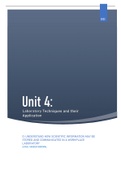2022
Laboratory Techniques and their
Application
D: UNDERSTAND HOW SCIENTIFIC INFORMATION MAY BE
STORED AND COMMUNICATED IN A WORKPLACE
LABORATORY
AJMAL SHEKEB NOORMAL
,1 Storing and communicating information in a
laboratory
Scenario
I work as a lab technician in a pharmaceutical company's development department,
where we create and manufacture new pharmaceuticals. The lab maintains the
confidentiality of medication development information. It also keeps track of personal
and secret information about volunteers who participate in medication studies. My
bosses have requested me to write a study assessing the difficulties in storing and
transmitting the wide range of data captured and processed in the lab, comparing the
development lab's systems to those in the production department.
Laboratory Information Management System
The Laboratory Information Management System is software that aids in the effective
handling of samples and data. A LIMS may assist your lab automate procedures,
integrate equipment, and manage samples and associated data. To boost productivity,
you can also get more consistent findings faster and track data from sequencing runs
over time and between trials. Although the primary role of a LIMS is to track and
manage samples, it can do much more. It can help with process automation, which
lowers the risk of human mistake. Quality control data should be centralised in terms
of access and storage. Support efforts to verify compliance, track reagents and lots,
and other similar tasks. Perform instrument run monitoring, begin downstream data
processing, and integrate with instruments or other in-lab systems to improve lab
efficiency.1
The organisation of the team that scientists and technicians work in, as well as how
each team member interacts with one another, greatly influence the work that they
do. There is typically a hierarchy at work.10
This implies that various levels of staff will report to the most senior individual.
Organizing this will rely on: 10
the size of the team
the specific tasks performed in the workplace
if the team is dispersed over a vast region or various places
if the team is divided into smaller groups that are assigned certain tasks to do
at specific hours of the day or night.
Regardless of how employees are set up, the organization's safety and efficiency
depend on how well they communicate both inside and outside of their team. 10
No of the size of the team, traceability is necessary inside every organisation. This
implies that each team member must accept accountability for their contributions.
It's possible that they need to initial paperwork and employment records. For
instance, once a procedure is finished and the report has been written up, all staff
members responsible sign the report's bottom. In some circumstances, a report will
only be approved by a management or team leader. Once more, this will depend on
the team's size and the management style used by the organisation. The company
will have a policy in place for this. Any staff members will have a secure login
password for all work that is recorded on computer systems since security is also
, 2 Storing and communicating information in a
laboratory
crucial. This login will probably need to be updated frequently in order to maintain it
safe.10
Large volumes of information will be generated over the course of laboratory activity.
Data storage in order to access it later has become increasingly crucial. Since the
introduction of the computer to the workplace, record storage has undergone
significant transformation. Hard drives and the Cloud, where the majority of the data
is stored, have largely replaced big boxes or file cabinets of papers in most
organisations. 10
In order to prevent data loss, businesses frequently purchase secure cloud storage.
Utilizing a computer and cloud storage has several advantages. 10
Compared to the area required for paper storage, substantially less room is
required for computer storage.
Compared to a lot of paper, computer storage poses less of a fire danger.
It is quick to search data that is saved on a computer or in the cloud.
A variety of websites offer access to records. This eliminates the need to
produce and transport paper copies to other places. Time is saved, and the
chance of loss is eliminated. Additionally, it is safer because only personnel
with the right login credentials may access them.
Records can be updated rapidly, and technicians are less likely to use
outdated data.
Various types of data, such as the following, may need to be kept in a laboratory: 10
information resulting from laboratory-based research
information on staffing levels
Staff members' private information
information about tools and resources.
If data is to be maintained safe, secure, and accessible in the future, it must be
managed carefully. There is a risk that personal information might be exploited or
fall into the wrong hands as more businesses utilise computers to store and process
personal information. 10
These questions must be able to be addressed by organisations. 10
Who would have access to this data?
To what degree is the data accurate?
Would it be simple to copy?
Is it feasible to store a person's information without that person's knowledge
or consent? (Organisations must adhere to protocols to guarantee data
security.)
Are any modifications to the information documented?




